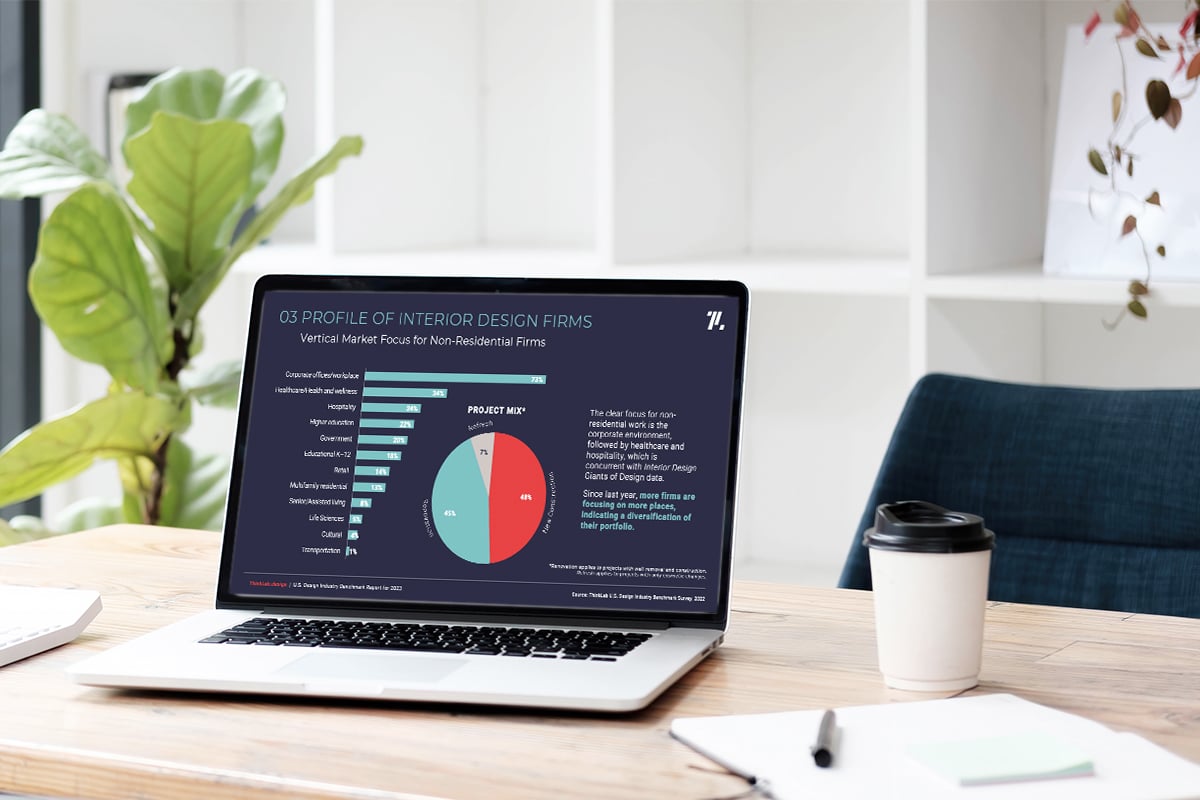Design Industry Benchmark Report for 2023
Discover what we learned from surveying 1,000+ interior designers about trends, challenges, and more.


- Chapter I: Introduction
- Chapter II: The Economic Power of Design
- Chapter III: Profile of the U.S. Interior Design Profession
- Chapter IV: Profile of Interior Design Firms
- Chapter V: Personal Profile of Interior Designers
- Chapter VI How Designers Work
- Chapter VII Designer Needs and Resources
- Chapter VIII What's Inside
Introduction
Let’s face it. The interior design industry is changing rapidly. If you are a manufacturer, distributor, or service provider to the industry who needs designers to specify your products, you need design industry statistics on where to reach them, how they work, and what they need from you to keep them coming back to your brand. As the premier market research firm in the interiors industry — and sister company to SANDOW DESIGN GROUP’s media brands, INTERIOR DESIGN, Metropolis, and Luxe — ThinkLab surveyed more than 1,000 design professionals this year to help you understand just that.
This summary showcases our collection of year-over-year design industry data outlining where U.S. designers live, how survey respondents work, and what they need most from product manufacturers. You’ll learn about vertical market projections, trade show attendance, professional association memberships, and where they find new products.
ThinkLab’s yearly U.S. Design Industry Benchmark Report is your ultimate guide to understanding the differences between how residential and non-residential designers work and the shifts in where they’re located so you can target them most effectively.
Here are the six topics we’ll cover in this article as a preview of what you’ll find in the full report:
- The Economic Power of Design
- Profile of the U.S. Interior Design Profession
- Profile of Interior Design Firms
- Personal Profile of Interior Designers
- How Interior Designers Work
- Designer Needs and Resources
The Economic Power of Design
How many fish can you catch with just a pole? One at a time, right? Fishing is a great pastime, but if you rely on it for your livelihood, you need a good boat, a big net, and some tasty bait to cast where the fish are biting to maximize your effort.
The same is true for growing your business in the interiors industry.
Did you know that architects and designers (A&D) are the largest influencers to the buying process? So, while they may or may not currently be the primary focus of your sales and marketing efforts, they deserve your consideration.
Designers have 26 times the specification power as the average consumer has buying power (and that power grows to 111 times when the designer works at one of the top 200 INTERIOR DESIGN Giants of Design firms). And even though designers don’t typically buy directly, they drive growth of numerous product categories through specification and client influence.

Want to know what issues are top of mind for the designers who work at the largest 200 firms in the U.S.? Listen to ThinkLab’s Mpowered podcast episode, “What’s Hot on the Minds of the INTERIOR DESIGN Giants of Design, and How Should Reps Respond?”
Profile of the U.S. Interior Design Profession
Now that we know what kind of fish we want to catch — the big ones, right? — it’s important to know where to find them.
There are over 90,000 designers in the U.S. One of the design industry statistics ThinkLab tracks is the top 10 cities with the highest designer employment each year. These are the places to concentrate showrooms and trade shows and consider adding or strengthening a direct sales presence.
While New York and California are historically large design markets, places like Miami have skyrocketed since last year, growing 66 percent in designer employment due to favorable economic conditions down South and a growing “work from anywhere” mentality that arose from the pandemic.
These top 10 cities also happen to be the locations of a majority of the headquarters for the INTERIOR DESIGN Giants of Design firms (those with four times the specification power of a designer at a smaller firm).
This map can help guide your strategy if you are:
- Looking for showroom space
- Deciding where to strengthen your sales presence
- Considering a sales blitz

Metropolitan Areas with Highest Designer Employment
New York City
The Big Apple remains #1 on our list with 5,670 designers.
Los Angeles
Even in a decline, LA sits still at #2 with 3,450 designers.
Miami
At 2,600 designers, Miami moved up 6 spots (from #9 to #3).
Profile of Interior Design Firms
When ThinkLab surveys non-residential designers, one of the questions we ask every year is where specifiers expect to see the greatest growth potential in the coming year. This allows us to:
- Track activity by vertical market year over year to assess their health relative to one another
- Help manufacturers serving these markets know where activity is hot
- Give product marketers an understanding of how they might reposition existing products into newly emerging or recently hot markets
What’s hot in 2023?
- Even though the corporate market was hit hard during the pandemic, survey respondents expect to see growth in the coming year. In fact, the share of respondents who see growth potential in the corporate market rose by 18 percent compared with last year.
What's changed since 2019?
- Hospitality has historically been a larger market than healthcare, but during the pandemic, those two vertical markets switched positions, due to the negative impact of COVID-19 on travel, as well as the growth of the healthcare market. The top 200 INTERIOR DESIGN Giants of Design expect that in the coming year, hospitality will once again overtake healthcare, so we’ll keep tracking as the year unfolds.

Vertical Markets with the Most Growth Potential for A&D Firms
- Corporate/workplace design
- Healthcare design
- Hospitality design
- Higher education design
Personal Profile of Interior Designers
One of the most important things that manufacturers servicing the design industry need to know is where and how best to call on designers to get their products into the bid documents that ultimately get specified.
The process of selling to designers has drastically changed, moving away from reps coming to the office for a face-to-face sit-down presentation of the latest new product. Instead, ThinkLab research now finds that “15 minutes is the new 1 hour,” when it comes to the average time a designer is willing to dedicate to meeting with a sales rep.
One of the biggest drivers behind this shift is the fact that most designers are not working from the office full-time anymore. ThinkLab has been measuring back-to-work sentiment quarterly since the onset of the pandemic, and in that time, 3 out of 4 architects and designers have expected to remain working remotely in some capacity in the future.
That means the way that sales representatives call on A&D needs to evolve to meet designers where they are, with only what they need, in the short amount of time they have to absorb the information they’re being sold.

- 74% of non-residentially focused A&D are hybrid or fully remote.
- 70% of residentially focused A&D are hybrid or fully remote.
Have you adjusted your sales and marketing to a hybrid workplace?
If you need some inspiration, listen to ThinkLab’s Design Nerds Anonymous podcast episode, “The Future of Product Selection,” to understand more about the impact of hybrid work on the sales journey.
How Designers Work
If you’ve ever wondered what a day in the life of a designer looks like, you’re in luck. We survey and track this year over year and then break down the data by design focus, comparing residential and non-residential designers. This allows us to uncover design industry insights about how product manufacturers and sales reps can better support both groups during the design process.
Last year, the majority of A&D (regardless of design focus) spent their time completing drawings and presentation packages to communicate their overall design intent to clients. This year, that has shifted as residentially focused designers are spending more of their time sourcing and selecting products instead. This could be because of the residential boom, combined with supply chain issues due to the pandemic.
Did You Know?
ThinkLab research from design industry roundtable events shows that if a product ends up in a drawing file during the early phases of the design process, it is 60 percent more likely to end up making it all the way through to being specified.

ThinkLab likes to say that the biggest future change in this industry will come from process innovation, not product innovation.
How Can Manufacturers Streamline a Designer’s Specification Process?
- Provide BIM files for architectural drawings to help designers render products more effectively, which helps clients visualize those products in the space.
- Add the ability to search and filter by product, application, vertical market, price, sustainability feature, etc., on your website.
- Include product reviews from trusted peers that can tout your products in recommended configurations or installation settings.
Designer Needs and Resources
According to our U.S. Design Industry Benchmark Survey, designers look for inspiration and information in a variety of places, so it can be frustrating to determine where to prioritize your sales and marketing efforts — until now.
Where Architects & Designers Go for Information
-
Manufacturer websites
-
Manufacturer sales reps
-
General internet search
Trade publications are (still) a designer’s go-to resource for inspiration. As they look to get details on specific products, their sources shift.
When it comes to information, designers are typically:
- contacting their reps
- visiting a manufacturer’s website
This year’s survey results revealed that manufacturer websites, which were ranked #12 on the list of inspiration sources last year, rose to a shocking #2.
As a source of information, manufacturer websites climbed from #2 to #1, switching places with sales reps!
Now fear not, this does not mean the role of the rep is any less important. The reality is designers prefer, first and foremost, to self-serve everything they can, and then to reach out to their representative (AKA trusted advisor) for help on the more complex needs and nuances of their projects.

Read ThinkLab’s “Top 7 Places Architects and Designers Turn for Inspiration” for a deep dive into these top sources and to learn our recipe for inspiring and delighting A&D.
U.S. Design Industry Benchmark Report: What's Inside
It’s easy to be surrounded by data yet starved for insights. The ThinkLab difference is in translating the “So what?” into “Now what?” to empower you to make a difference and grow your business.
Understanding which design firms to target, which cities need the most sales support, at which points of the design process you can alleviate stress, and how you can call on A&D who are working in a hybrid capacity — all these elements are crucial for helping to shift your business strategies to align with this key group of specification powerhouses. With our full, complimentary U.S. Design Industry Benchmark Report, you have what you need to make data-driven decisions with even more confidence. And confidence is one thing we all want more of looking into the coming year.
Unlock the full report for the data you need on the U.S. Design Industry

Download the Full Report
Contributors:

Amanda Schneider
ThinkLab Founder & President

Erica Waayenberg
Head of Research

Allison Roon
Research & Content Development